Our Latest Blogs
Our Solutions News Blog was envisioned to gather and share information from the very best to help you and your business to become more effective.
Our Solutions News Blog was envisioned to gather and share information from the very best to help you and your business to become more effective.


Johnny Canuck was a Canadian cartoon hero and superhero who was created as a political cartoon in 1869 and was later re-invented, first in 1942, then in 1975.
Johnny Canuck was created as a lumber jack national personification of Canada. He first appeared in early political cartoons dating to 1869 where he was portrayed as a younger cousin of the United States’ Uncle Sam and Britain’s John Bull. Depicted as a wholesome, if simple-minded, fellow in the garb of a habitant, farmer, logger, rancher or soldier, he often resisted the bullying of John Bull or Uncle Sam. For thirty years, he was a staple of editorial cartoonists. Then, in the early twentieth century, he faded from view.
The character re-emerged during World War II in the February 1942 issue of Bell’s Dime Comics No.1. Cartoonist Leo Bachle created the character as a teenager, apparently on a challenge from a Bell executive.
Source: Vancouver Canucks History
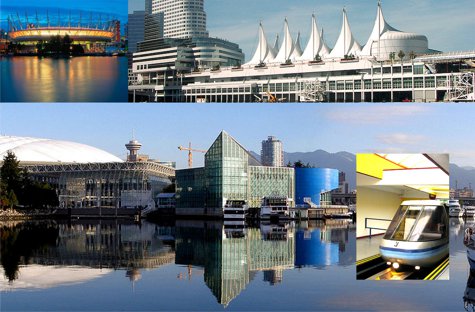
The 1986 World Exposition on Transportation and Communication, or simply Expo '86, was a World's Fair held in Vancouver, British Columbia, Canada from Friday, May 2 until Monday, October 13, 1986. The fair, the theme of which was "Transportation and Communication: World in Motion - World in Touch", coincided with Vancouver's centennial and was held on the north shore of False Creek. It was the second time that Canada held a World's Fair, the first being Expo 67 in Montreal (during the Canadian Centennial). It was also the third World's Fair to be held in the Pacific Northwest in the last 25 years as of 1986 and as of 2012 it still stands as the latest World's Fair to be held in North America.
You'll want to Click Here to take a look back.
The logo of three interlocking rings to make the 86 in the logo stood for the three main modes of transportation; land, air, and water.
Up until the late 1970s, the 173 acre (0.7 km2) site on False Creek, where Expo was staged, was a former CPR rail yard and an industrial wasteland. In 1978, Sam Bawlf (then BC Minister of Recreation and Conservation) proposed an exposition to celebrate Vancouver’s Centennial year (1986). The proposal was submitted in June 1979, for a fair that was to be called “Transpo 86.” In 1980, the British Columbia Legislature passed the Transpo 86 Corporation Act, paving the way for the fair. The transportation theme reflected the city’s role in connecting Canada by rail, its status as a major port and transportation hub, and the role of transportation in communications.
The initial idea was to have “…a modest $80 million transportation exposition that would mark Vancouver’s 100th anniversary.” It soon blossomed into a full exposition thanks to the help of the Vancouver Exposition Commissioner-General at that time, Patrick Reid. The theme of Transportation and Communication led to the conglomeration of many different exhibits of transportation networks. This included a monorail that glided over the crowds that included a trip to every zone. Other ground transports included a Skytrain, a High Speed Surface Transport from Japan, and a French “People Mover.” (basically a little boxcar). The transports of the sky was the Gondola, a boxcar hovering high in the air. The water taxis moved along four different ports on the site.
The fair was awarded to Vancouver by the Bureau of International Expositions in November 1980. However, once it became clear that the event would be a world exposition, the name was officially changed to “Expo 86″ by Ambassador and Commissioner General Patrick Reid in October 1981, and, by the end of the year, Expo 86 Corporation was established as a nonprofit agency responsible in the planning and operation of the fair.
Local business tycoon Jim Pattison was appointed as CEO, and would eventually also become the president of the corporation. The chief architect selected was Bruno Freschi, the Creative Director was Ron Woodall, and Bob Smith was responsible for the production and design.
Construction started in October 1983, when Elizabeth II, Queen of Canada, started a concrete mixer on the future site of the Canada Pavilion, and offered the “invitation to the world.” But, work was disrupted by labour disputes for 5 months. Still, Expo Centre opened May 2, 1985, as a preview centre for the fair.
The fair was originally budgeted for a modest CAN$78 million. However, final expeditures for the expanded event totaled $802 million with a deficit of CAN$311 million.
Expo ’86 was opened by Charles, Prince of Wales, Diana, Princess of Wales, and Prime Minister Brian Mulroney on Friday, May 2, 1986. It featured pavilions from 54 nations and numerous corporations. Expo’s participants were given the opportunity to design their own pavilion or opt for the less expensive Expo module. Each module was approximately two-and-a-half stories high and had the floor space equal to a third of a city block. The design was such that any number of the square modules could be placed together in a variety of shapes. The roof design allowed the interior exhibit space to be uninterrupted by pillars.
Source: Wikipedia
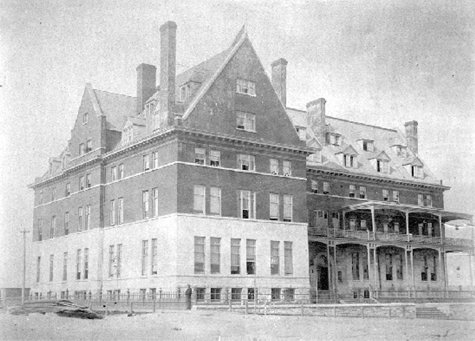
The Canadian Pacific Railway needed a hotel to serve the passengers arriving on their trains at the station located at the foot of Granville Street. T.C. Sorby had designed the station, and he got the job of designing the hotel too. It was up Granville – not too far, but enough to leave some space for new CPR sponsored commercial buildings, and to pull some activity away from the earlier city centre to the east, where there were already plenty of hotels (none of them on CPR land).
Sorby’s hotel opened in mid 1888 to a design that even he didn’t like – complaining of CPR cutting what they considered to be superfluous details – which in those days were what architecture was often about. The CPR were supposedly equally unimpressed – Sir William Van Horne, the CPR President is reported to have said to Sorby “so you’re the damn fool who spoilt the building with all those little windows”. One local newspaper even likened the building’s design to a workhouse. An 1897 newspaper, ‘The Ledge’ published a story which ran “The Vancouver World publishes a long letter from the executive agent of the CPR to the city council, requesting exemption from taxation for buildings proposed to be erected for a passenger station and warehouses. The World publishes cuts of the proposed structures which are said to be in the Queen Anne style of architecture and are fully in keeping with that monument of external ugliness, the company’s hotel Vancouver. The architectural illustrations in the World resemble a compound of a decayed grist-mill with bits of the bastile and the tower of London added.”
Presumably looking for a better response the CPR hired Francis Rattenbury to design the 1893 addition to the south. Rattenbury had only recently arrived in Canada, but at the age of only 25 he had just won the competition for the new parliament buildings in Victoria. In Yorkshire, where he had arrived from, he had been designing buildings in the ‘model’ mill town of Saltaire – or so he told the Vancouver Sun, although actually he hadn’t even been born when that development had taken place. His design for the hotel extension didn’t really have much to do with the original building. Although Sorby’s hotel was identified for replacement as early as 1900 it was still around for a few more years.
Rattenbury was hired to design a further extension to the original in 1901, which he carried out in an Italienate style that isn’t so very different from his design for the city’s new courthouse five years later. Rattenbury fell out with the CPR, but was busy with other projects including the Empress Hotel in Victoria, so in 1910 architects Painter and Swales were hired to replace a much bigger and more elaborate replacement for both the first hotel and the 1893 addition which was eventually finished in 1916.
These days the site has the Cesar Pelli / McCarter and Nairne designed Pacific Centre Mall which is now anticipated to see a major redesign in the near future with Sears having confirmed their intention of leaving later in 2012.
Source: Changing Vancouver
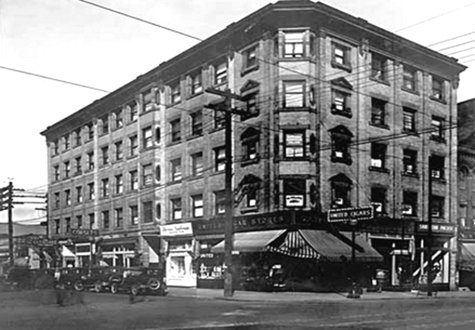
Dr. Simon Tunstall was born in Quebec, in 1852, qualified as a doctor at McGill University and moved to British Columbia in 1881. After practicing in Lytton and Kamloops he moved to Vancouver in 1892 with his wife and family and seems to have gained a favourable reputation which would extend to international recognition; when the American Medical Association met in Boston in 1906 Dr. Tunstall was identified in the Boston press as a ‘distinguished visitor’ of the Association, and he presided at the Canadian Medical Association meeting in Vancouver in 1904.
In March 1902 G.W. Grant obtained a building permit worth $1,600 to build the foundation for a building on Granville Street for Dr. Tunstall, and two months later another permit worth $22,000 to build a ‘stone and brick store’ which was built by D. Saul. In 1909 Dr. Tunstall spent a further $20,000 on adding to the building, Dissette and Dean carrying out the work and Grant again designing the building, by this time in partnership with Henderson.
The image above from 1927 shows the completed building at five storeys. Dr. Tunstall had Grant and Henderson design a house for him on 5th Avenue in 1911, and in 1912 they designed a $42,000 office building for him on Denman Street (although it doesn’t look like it was built).
In the early years of its existence the Tunstall Block’s tenants were (not surprisingly) doctors, including a husband and wife chiropractic team. The building stayed on Granville Street for many years, replaced eventually by the northern block of the Pacific Centre Mall, designed by Zeidler Roberts Partnership and not completed until 1990. In 2007 the corner of the block had a radical redesign by Janson Goldstein of New York for the new Holt Renfrew store, incorporating panels of slumped glass in the design.
Source: Changing Vancouver
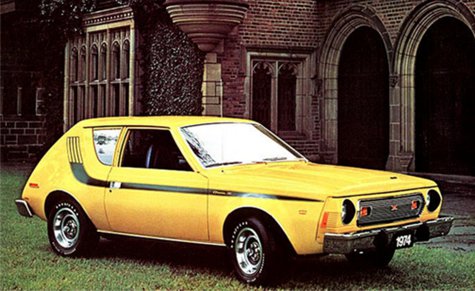
American Motors designer Richard Teague—remember that name—was responsible for some of the coolest cars of the era. The Gremlin wasn't one of them. AMC was profoundly in the weeds at the time, and the Gremlin was the company's attempt to beat Ford and GM to the subcompact punch. To save time and money, Teague's design team basically whacked off the rear of the AMC Hornet with a cleaver. The result was one of the most curiously proportioned cars ever, with a long low snout, long front overhang and a truncated tail, like the tail snapped off a salamander. Cheap and incredibly deprived—with vacuum-operated windshield wipers, no less—the Gremlin was also awful to drive, with a heavy six-cylinder motor and choppy, unhappy handling due to the loss of suspension travel in the back. The Gremlin was quicker than other subcompacts but, alas, that only meant you heard the jeers and laughter that much sooner. You'll want to Click Here to view the other 49.
Source: Time Magazine
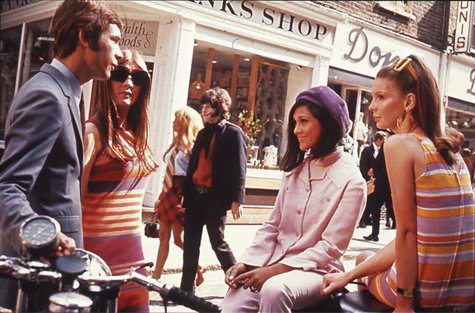
The 1960s featured a number of diverse trends. It was a decade that broke many fashion traditions, mirroring social movements during the period. In the middle of the decade, culottes, box-shaped PVC dresses and go-go boots were popular. The widely popular bikini came into fashion in 1963 after being featured in the musical Beach Party.
Mary Quant invented the mini-skirt, and Jackie Kennedy introduced the pillbox hat, both becoming extremely popular. False eyelashes were worn by women throughout the 1960s, and their hairstyles were a variety of lengths and styles. While focusing on colours and tones, accessories were less of an importance during the sixties. People were dressing in psychedelic prints, highlighter colours, and mismatched patterns. The hippie movement late in the decade also exerted a strong influence on ladies' clothing styles, including bell-bottom jeans, tie-dye, and batik fabrics, as well as paisley prints.
In the early-to-mid-1960s, the London Modernists known as the Mods were shaping and defining popular fashion for young British men while the trends for both sexes changed more frequently than ever before in the history of fashion and would continue to do so throughout the decade.
Designers were producing clothing more suitable for young adults which lead to an increase in interests and sales.
Sources: Wikipedia
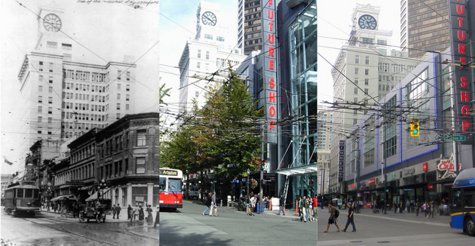
It’s unusual to have three (almost) lined up images, but here’s the east side of Granville Street around 1912 when the new and very impressive Vancouver Block had just been completed, looming over the much smaller two and three storey brick buildings. Faced in terra cotta, the Vancouver Block was designed by Parr and Fee for Dominic Burns who ran the BC arm of the family meat business established by his Alberta-based brother, Patrick. P. Burns & Co which became western Canada’s largest meatpacking company and eventually Burns owned 700,000 acres of ranch land.
Dominic looked after the British Columbia part of the business, and was wealthy enough to fund the $400,000 Vancouver Block in 1910 (with completion in 1912). Dominic moved to the top floor penthouse where he lived until 1933. In the same year the more ornate, and more expensive, Birk’s Block was completed just to the north on the same block, but that was lost in the mid 1970s to make way for the Vancouver Centre. Both buildings had a large number of small companies operating from the building. In the Vancouver Block there were as many as 17 different businesses on one floor. The rest of the block included the Windsor Hotel (later called the Castle Hotel) and the New Orpheum Cafe and Grill, while the building on the corner of Robson was for many years the Royal Bank.
In 2003 a new 3-storey retail store designed by Studio One Architecture was completed, with a top floor Winners store and a Future Shop below it, and a number of smaller retail units on the Granville Street level. The middle picture shows the old version of the transit mall soon after the new retail block was completed; the newly designed street has vertical white low-energy lighting.
Source: Changing Vancouver
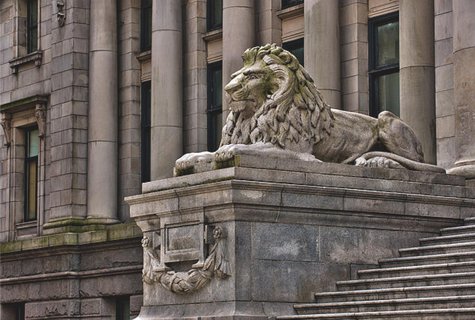
Originally built as Vancouver's courthouse, it was designed by Francis Rattenbury in the classical style. Nelson Island granite was used for the base section and Haddington Island stone for upper levels. The two lions flank what was originally the main entrance were carved by John Bruce — a Scottish artisan who was working in Vancouver, assisted by Tim Bass — from granite from the appropriately named Granite Island near Pender Harbour. They are modeled on London's Trafalgar Square lions by Sire Edwin Landseer. The King Edward VII Memorial Fountain echoes the structure of the main building with its similar pillars and formal structure. The building was completed in 1911.
A 184-foot flagpole, erected in 1912 in the front courtyard--allegedly the tallest in the world--was taken down in 1936 due to safety concerns. The Italian black marble fountain designed by R.H. Savery and sculpted by Count Alex von Svoboda, was opened December 15, 1966, in commemoration of the 1866 union of colonies of Vancouver Island and British Columbia. The building was renovated in 1979-82, by architect Arthur Erickson for its new life as the Vancouver Art Gallery. The original front entrance now remains unused. The gallerys back steps on Robson Street have become a favorite place for Vancouverites to meet, sell their crafts, hold public rallies, or just hang out.
Sources: Vancouver Then and Now
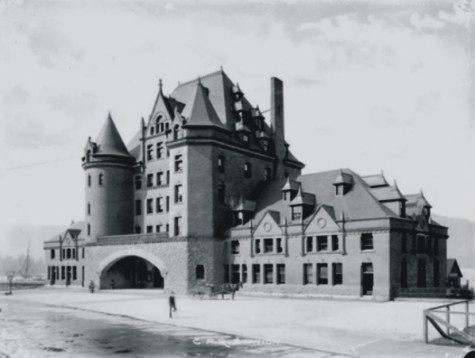
Here's the newly completed CPR station in about 1900. Not T C Sorby's first station that lasted a very short time just over 10 years. This one sat right at the foot of Granville Street, and despite its grandeur it only lasted fifteen years before being replaced by the one still standing today.
The designer was a German immigrant, Edward Colonna (who had changed his name from Klonne when he became a US citizen). Colonna came to CP from designing the interior of rail coaches, and before that working in New York for Louis Comfort Tiffany. On leaving CP in the early 1890s as the railway boom was ending he designed for Maison de l'Art Nouveau in Paris, both jewellery and furniture. He then moved to Toronto, where he worked for 20 years before retiring to Nice where he died, aged 86, having been paralyzed and bedridden for over 20 years.
Colonna's station design was only partly complete when a severe down turn in the economy saw construction halted. The building's final appearance was completed in 1899 by Montreal based (and born) architect Edward Maxwell, who reworked Calonna's design but stayed true to its Gothic style. Indeed for the now demolished Ottawa station he adopted a similar chateau style, and for an economy sized version head to The Keg in New Westminster where Maxwell's $35,000 1899 station can still be found.
Today the site consists of a parkade that's associated with the offices in the replacement station and the office tower at Granville Square built in the 1970s as one of the few completed parts of Project 200, a huge urban renewal scheme that would have seen Gastown swept away.
Source: Changing Vancouver
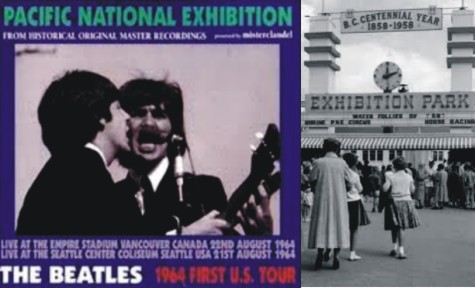
Appropriately enough for a part of the city that was founded on tourism and hotels, the former Hastings Townsite became home to one of the city's biggest attractions.
In 1908, a group of East End realtors got together to plan an exhibition, the precursor to the Pacific National Exhibition (PNE). They wanted to put on a show as impressive as the Royal Agricultural Show in New Westminsterbut that would be within the reach of a five-cent [street]car fare.
With an eye on the 160-acre Hastings Park, used for little more that horse racing since the province had granted it to the city in 1889, they asked both the City of Vancouver and the provincial government for startup funds. The city put a bylaw before voters, asking ratepayers to approve a $25,000 grant, but the voters said no. So did the province.
The premier, Mr. Richard McBride, candidly and frankly told the deputation who waited upon him that the government opposed the movement which it calculated would be destructive to the established Royal Agricultural Society at New Westminster, and that no assistance could be looked for from that quarter, recalled Vancouver Exhibition Association co-founder John James (J.J._ Miller, writing in the 1930s).
Instead the founders turned to private funds to raise the capital they needed to mount their show. Miller, who served as president of the exhibition from 1908 to 1921, bought the first $100 life membership, and co-founders Professor Edward Odlum and George McSpanddenboth East End realtorsbought life memberships numbers two and three. Eventually the co-founderswho also included realtor Thomas Duke and newspaper writer J. Field-Johnsonmanaged to raise $20,000.
A few months later, the city again asked voters to contribute the exhibition, and a bylaw for a $50,000 grant passed.
Money in hand, the exhibition's first board of managementwhich included Charles Woodward, founder of the department storebuilt a handsome show building on 60 acres of parkland leased from the city. Originally called the Exhibition Building, it was later renamed the Industrial Hall, and eventually the Women's Building. Located at what today is the corner of Oxford and Renfrew streets (it was demolished in 1938), it was an impressive looking building with columns, turrets and a half-dome ceiling over the front entrance.
The Exhibition Building opened in September 1910 with so many exhibits entered, organizers had to scramble to get pens for livestock and housed the poultry in a large tent.
Prime Minister Wilfred Laurier opened the fair with a gracious speech of goodwill and good wishes on a beautiful sunny day. A trotting race followed the opening ceremonies, after which Laurier took a walking tour of the exhibit and attended an afternoon tea, presided over by Miller's wife, in a large marquee on the grounds.
Some 68,000 people paid 50 cents each to attend that first exhibition, which tallied up a net profit of $8,825.
This far exceeded the wildest expectations of the promoters, and gave them renewed vigor, hope and encouragement, wrote Miller.
The provincial government did an about-face, with McBride sending a letter conveying his best wishes to the exhibition on its opening daytogether with a cheque for a $10,000 grant.
The Vancouver Exhibition soon rivaled those in Victoria and New Westminster. The latter, contrary to predictions, did not go out of business right away, but lingered until 1930.
Source: Vancouver, Stories of a City by Lisa Smedman
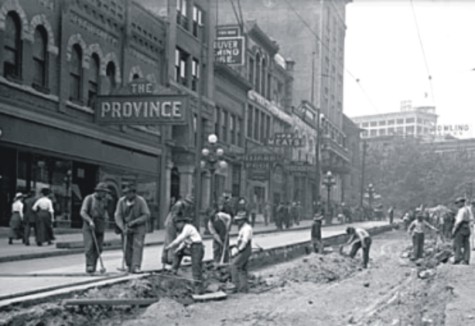
One of the early shop locations for the Dominion Blue Print & Drafting Co. was in the Ormidal Block 151 West Hastings. The 1912 image above shows the back breaking labour it took to install new sewage and roads back then.
A number of buildings on this block were built in the late 1890s, and an original Woodwards store was one of them. The building has been used as an art gallery for many years, but it started life in 1898 as the offices of the Province Newspaper, Walter Nichol's Victoria newspaper that moved into Vancouver and eventually took out Francis Carter-Cotton's rival News-Advertiser in 1924, moving to his smarter offices in the process. In 1926 'The Arcade' a retail centre that may have replaced one of the same name that had been built on Hastings at Cambie in 1894 by Harvey Haddon, originally from Nottingham in England. The Arcade took in the main floor of the Stock Exchange Building next door as well, and was designed by Townley and Matheson. Later it became the National Furniture Store.
Massive changes have occurred on the block in the past few years at one time almost everything was abandoned or so run down that it looked like it would be demolished or converted to housing. However, recent demand for character office space and the impact of the Woodwards redevelopment project have seen clean up and refurbishment of many of the buildings.
Source: Changing Vancouver
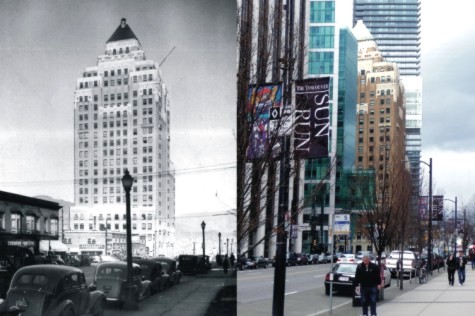
In terms of financial supervision, it may not have helped that the owners, G A Stimson and Co, were based in Toronto when the Marine Building was being built in the extraordinary time of only 16 months from start to finish. The design was local, McCarter and Nairne letting their imaginations run riot on this Mayan influenced deep-sea fantasy, with seahorses, pufferfish (and the odd zeppelin for contemporary reference) in the details. But the budget was blown wide open the cost was over $2.3 million, fifty percent over the original estimate, and if the economy was looking shaky in 1929 when building started it looked positively terrible in 1930 when it opened. So despite the lavish gala when it opened and the beautiful uniformed young women in front of the handmade solid brass elevator doors, nobody was heading upstairs. By 1931 the owners were willing to let the building go at less than half price as a new City Hall.
In 1933 it was knocked down to British Pacific Building Co for $900,000. Fred Taylor, the prime mover of the deal, moved into the penthouse at the top of the building and persuaded the Guinness family to back the investment. Taylor didn't live there much as the elevators closed in the evening, stranding Taylor and his wife on the 19th floor. In the 1940s it became another office space in a consistently popular building for tenants, and the most significant Art Deco masterpiece in the city, and among the best in North America.
When it opened it stood alone on the escarpment, away from the city (which may have contributed to the difficult of leasing it initially). Now its surrounded on all sides by commercial towers, and an even taller one is just being built immediately behind it by Oxford Properties, who own the Marine Building today.
Source: Changing Vancouver
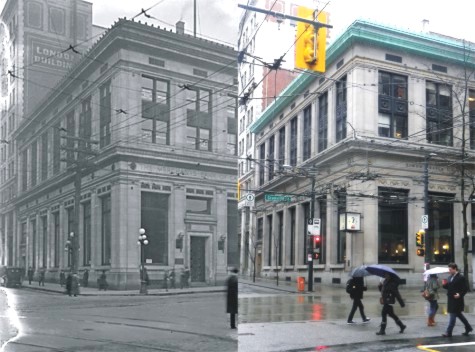
At first glance there's virtually no change between this 1922 shot of a 1915 building, and how it looked in the Vancouver rain. But looking closer, there are differences, and they reflect an evolving role for the building. In 1916 this was the new Merchants Bank, designed by Somervell and Putnam, both Americans who worked in Seattle before Vancouver. For young, recently arrived architects they picked up a remarkable set of important commissions in a very short time, and in turn delivered a set of buildings that are among the best that were built in a fiercely competitive period of growth.
The Merchants Bank was one of many trying to tempt new clients, so the building had to show style while implying solidity. The architects went with a classical theme a temple bank of three storeys (pretending to be two). By 1923 the Bank of Montreal had subsumed the Merchants Bank, and Kenneth Guscotte Rea, their architect, was given the job of doubling the size of the bank, which he achieved almost seamlessly. That's when the doorway disappears the older picture shows the entire building, the contemporary image only half the building.
By the 1990s the Bank of Montreal had no future use for the building, and it sat unwanted, and with an uncertain future. In the early 1990s Joe Segal, Vancouver businessman and property developer bought the building, donated it to Simon Fraser University, and kick-started a restoration fund that raised nearly $20 million to convert the building into the the Segal Graduate School of Business. Extensive and sensitive renovations and restoration, designed by Merrick Architecture, now see the building with a solid future to match its architectural integrity.
Source: Changing Vancouver
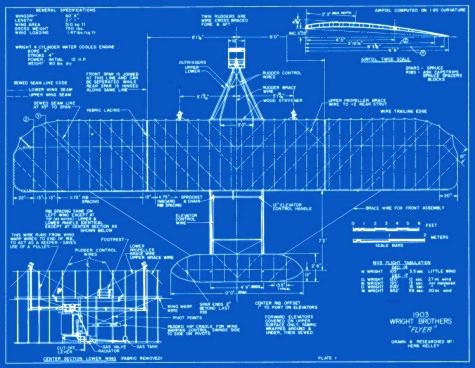
Now of course we didn't print the Wright Brothers blueprints, but it does give you an idea of how long we've been around. As we all know, the Wright brothers were two Americans credited with inventing and building the world's first successful airplane and making the first controlled, powered and sustained heavier-than-air human flight, on December 17, 1903. In the two years afterward, the brothers developed their flying machine into the first practical fixed-wing aircraft. Although not the first to build and fly experimental aircraft, the Wright brothers were the first to invent aircraft controls that made fixed-wing powered flight possible.
The brothers' fundamental breakthrough was their invention of three-axis control, which enabled the pilot to steer the aircraft effectively and to maintain its equilibrium. This method became standard and remains standard on fixed-wing aircraft of all kinds. From the beginning of their aeronautical work, the Wright brothers focused on developing a reliable method of pilot control as the key to solving "the flying problem". This approach differed significantly from other experimenters of the time who put more emphasis on developing powerful engines. Using a small home built wind tunnel, the Wrights also collected more accurate data than any before, enabling them to design and build wings and propellers that were more efficient than any before. Their first U.S. patent, 821,393, did not claim invention of a flying machine, but rather, the invention of a system of aerodynamic control that manipulated a flying machine's surfaces.
They gained the mechanical skills essential for their success by working for years in their shop with printing presses, bicycles, motors, and other machinery. Their work with bicycles in particular influenced their belief that an unstable vehicle like a flying machine could be controlled and balanced with practice. From 1900 until their first powered flights in late 1903, they conducted extensive glider tests that also developed their skills as pilots. Their bicycle shop employee Charlie Taylor became an important part of the team, building their first aircraft engine in close collaboration with the brothers.
The Wright brothers' status as inventors of the airplane has been subject to counter-claims by various parties. Much controversy persists over the many competing claims of early aviators.
Source: Wikipedia